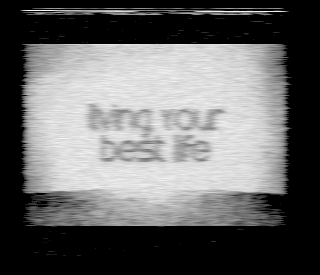Two Attempts at Receiving Video
The first project I attempted while I had time off from work was
reconstruction of the "TEMPEST"-type reception of CRT signals. I
referred in particular to an oft-cited (although largely unoriginal,
as I understand it) paper by van
Eck. Van Eck describes a "pulse shortening" mechanism, in which
the electron gun is not excited for the full width of a pixel, but
rather reduced, such that a solid white screen will produce a square
wave at the dot clock frequency. Perhaps it is a difference between
shadow mask and aperture grille CRTs, or technology has moved on in 20
years, but I did not find things to be as he described. A solid white
screen produced no radiation, nor did solid black; an alternating
checkerboard produced radiation at half the pixel clock and its
harmonics.
That was as far as I got on that one. A baseband signal from DC to
100 MHz? I saw no obvious way forwards with that. Having read about
it slightly more today, it sounds like the approach which is actually
taken is to select a higher harmonic - one where there isn't much
else, certainly far above broadcast radio and TV - and receive it with
~100 MHz bandwidth (it's quiet in the microwave, right?). Perhaps I
shall revisit that at some future time - at the moment I do not have a
receiver with anywhere near suitable bandwidth available, and it would
be a significant undertaking to construct one.
 The second thing I wanted to do was receive analog TV. The clock
is ticking on that, as analog TV will disappear early this year in
this country. Happily, I had more success with this one. I digitized
the signal and decoded it with a perl script. An example image is
shown to the right.
The second thing I wanted to do was receive analog TV. The clock
is ticking on that, as analog TV will disappear early this year in
this country. Happily, I had more success with this one. I digitized
the signal and decoded it with a perl script. An example image is
shown to the right.
The quality isn't very good, but the widest filter available on the
receiver I was using was 1 MHz, and TV should be closer to 6 MHz, so I
wasn't too surprised. You can see that there's horizontal smearing,
which is what you'd expect with insufficient bandwidth.
Looking at the received signal on the oscilloscope really made the
case for digital television. The extent to which it was
retransmitting nearly the same image over and over again was striking.
There really is something to be gained with modern video encoding
algorithms which transmit incremental updates.
 The second thing I wanted to do was receive analog TV. The clock
is ticking on that, as analog TV will disappear early this year in
this country. Happily, I had more success with this one. I digitized
the signal and decoded it with a perl script. An example image is
shown to the right.
The second thing I wanted to do was receive analog TV. The clock
is ticking on that, as analog TV will disappear early this year in
this country. Happily, I had more success with this one. I digitized
the signal and decoded it with a perl script. An example image is
shown to the right.